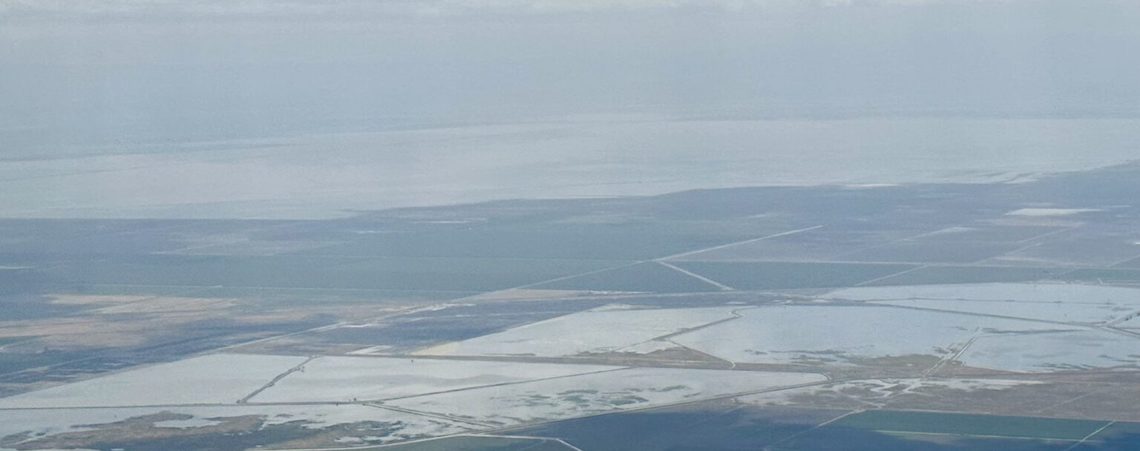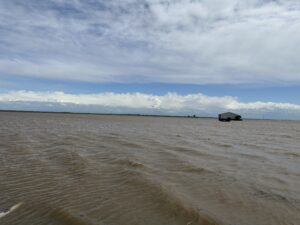
Tulare Lake stretches out in the distance like an inland sea in this May 1 aerial photo. Lois Henry / SJV Water
Written by Jesse Vad with SJV Water
The partially refilled Tulare Lake is so large, with so much water spread over so much land, that it’s changing nearby weather.
The lake stretches across the horizon as far as the eye can see in many places and is now about the size of Lake Tahoe.
The vast amount of water has started to change the weather nearby. Once the largest freshwater lake west of the Mississippi, Tulare Lake was drained more than 100 years ago for agriculture.
But it’s still the lowest spot in the San Joaquin Valley. So, when snow and rain slam the state as happened this year, the region’s typically placid rivers roar to life and seek their ancient terminus.
That’s what happened in March this year. And though levees have kept the lake refilled in patches, the sheer amount of water is amazing.
“Water has a fantastic ability to hold heat and also can cause cooling as it evaporates,” said Michael Anderson, state climatologist with the Department of Water Resources (DWR.) “So when you have a very large, relatively shallow body of water, like the reformed lake, you can get some localized evaporative cooling and definitely get a different kind of moisture profile.”
The effects can be felt only nearby the lake, said Anderson. The water can also lead to an increase in humidity, something that people can probably feel in the San Joaquin Valley where it is normally dry, he said.
In some instances, the lake could significantly drop local temperatures.
 Water in Tulare Lake has swallowed a farm south of Corcoran in this March 2023 photo. Lois Henry / SJV Water
Water in Tulare Lake has swallowed a farm south of Corcoran in this March 2023 photo. Lois Henry / SJV Water
With a heat wave rolling in over the weekend, temperatures in the valley are expected to soar upwards of 110 degrees. But immediately around the lake, temperatures could be around 95-100, said Carlos Molina, meteorologist at the National Weather Service’s Hanford station.
The lake also creates a pressure difference because of its cooler temperatures. That will create a lake breeze effect, said Molina.
“We’re looking at basically no winds, very light winds, across the San Joaquin Valley,” said Molina. “That area right there at the lake is actually going to feel a stronger breeze than anywhere else across the valley.”
Those changes might be sticking around for some time. The last time the lake formed in 1983, it took about two years for the water to fully dissipate.
But it may disappear more quickly this time around since it’s significantly warmer overall now than it was 40 years ago, said DWR’s Anderson.
The peak snowmelt has passed, he added. There is still more snow than average for this time of year though, said Anderson.
“The amount of water coming out of the mountains each day is a little bit less,” said Anderson.
This year’s historic water and snow came from a string of atmospheric rivers that slammed California this winter and spring. An average year usually sees about two or three, said Molina.
This year was still supposed to be part of La Niña, a weather pattern that typically brings drier weather to the valley.
“La Niña pretty much weakened to the point where by the end of this winter we were kind of more in what they would call a neutral zone,” said Molina.
So, instead of upper level winds moving up to Canada, they stayed around California bringing in all the moisture instead of sending it north.
The season was abnormal in the sense that we weren’t in La Niña or El Niño, said Molina.
“What was more interesting is just the fact that there was nothing actually able to stop the atmospheric rivers from coming towards us,” said Molina. “And that was kind of more of the abnormal side.”
Next winter is projected to be somewhat wet, said Molina. We will probably see atmospheric rivers, but likely not as many as this year, he added.
SJV Water is a nonprofit, independent online news publication covering water in the San Joaquin Valley. Lois Henry is the CEO/Editor of SJV Water. She can be reached at lois.henry@sjvwater.org. The website is sjvwater.org.








